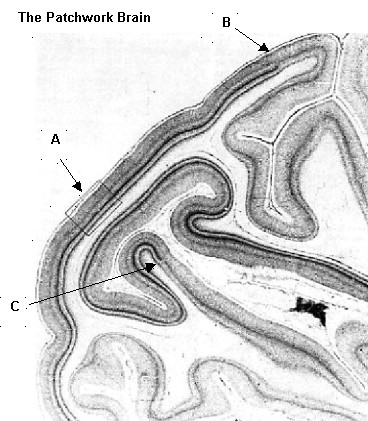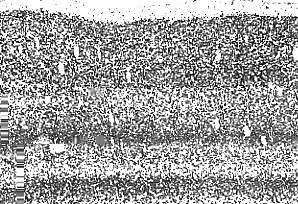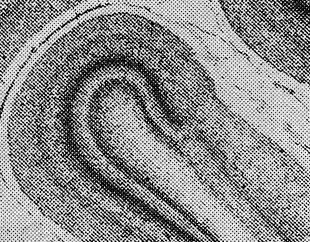
Hidden Talents and Brain Maps
Hiddentalents.org
© 2001 Stephen Holland --- sholland@softwaves.net
| 3 Inner | 5 L/R sides |
 Hidden Talents and Brain Maps Hiddentalents.org © 2001 Stephen Holland --- sholland@softwaves.net
|
Home | Index | Outer parts | |||||
| Input / Output | Inner parts | |||||||
| L / R Sides | Patchwork Quilt | |||||||
| Brain Maps | Print maps | |||||||
| LEFT Brain | RIGHT Brain | |||||||
| Activities | L / R Types | |||||||
| Balanced vs Expert | Men vs Women | |||||||
| Feedback | Sources | |||||||
|
|
||||||||
| 4. The Patchwork Quilt Brain |
| The Cortex The brain is not just a lump of "gray matter," it has a very logical structure. Billions of neurons grow and interlock into very specific arrangements.  The outer cortex layer is divided into very distinct patches, each with specific jobs or "talents." I call it the "patchwork quilt brain." This page shows the microscopic proof of how distinct each patch is, and the next page shows the arrangement of patches.  At left is a slice of the visual cortex of a monkey, at the back of the brain. The section below at A in the picture shows a close up view of the patch designed to first process information coming in from the eye, looking for lines and angles. Notice that the neurons are arranged into layers to do their job.  The Patchwork Cortex The cortex is divided into many specific areas or "patches", each with a specific job  B (below) and C (at right) show very distinct changes in layers and show the exact change from one patch to another. Being in the visual area, the neighboring
patches shown here might be designed to analyze
more complex visual detail such as depth
perception, motion perception, or object
recognition. B (below) and C (at right) show very distinct changes in layers and show the exact change from one patch to another. Being in the visual area, the neighboring
patches shown here might be designed to analyze
more complex visual detail such as depth
perception, motion perception, or object
recognition.  Patchwork Talents Patches are extremely important for understanding talents. Each patch represents specific abilities or talents, and vary greatly from one person to another. For example, imagine your own brain and the patch shown above for analyzing lines and angles.  If this patch of your visual cortex (ie:
the talent for discerning angles) is
well developed, you may be very concerned about whether
pictures are hung straight on the wall
because
your brain is very talented at noticing
slight
angle variations. If this patch of your visual cortex (ie:
the talent for discerning angles) is
well developed, you may be very concerned about whether
pictures are hung straight on the wall
because
your brain is very talented at noticing
slight
angle variations. On the other hand, if it is actually deficient, you may have trouble parallel parking, because you don't notice angles very well. You may have a well-developed patch or talent for analyzing angles and lines, but have a weakly developed patch or talent for depth and motion perception, so that you are good at perceiving the angle to park your car, but have trouble judging how far away the other car is and bump into it. Compensating for Injury If one patch of the cortex is damaged, then the other patches can not change their design and wiring! Instead, the brain tries to compensate by using different strategies. Also, many injuries are not total, and the patch may be only partially damaged, allowing for partial use. The exception is babies and very young children. When parts of the brain have not fully developed, then the brain patches may be able to regrow new connections somewhat. |